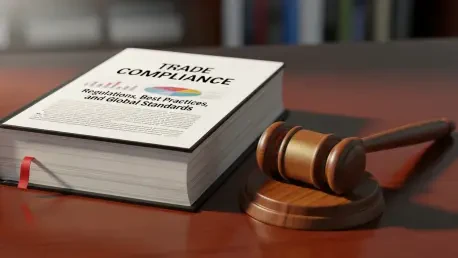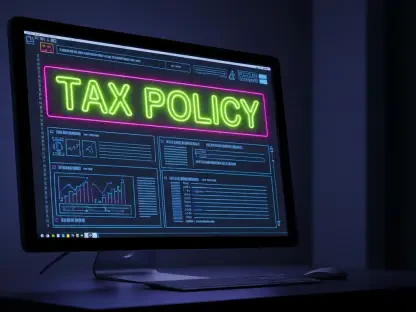Introduction to a Complex Trade Environment
In an era where global trade lanes account for a staggering $9.7 trillion in economic value, the stakes for compliance have never been higher, and businesses operating across borders face an intricate web of regulations that can make or break their supply chains. A single misstep can potentially disrupt flows worth billions. This dynamic environment, shaped by geopolitical tensions and rapid technological shifts, demands more than just adherence to rules—it requires strategic foresight. The complexities of modern trade compliance extend far beyond tariffs, touching on sustainability, labor standards, and real-time transparency.
The current state of the industry reveals a landscape under constant transformation. Companies are no longer merely navigating customs declarations but are also grappling with heightened scrutiny over ethical practices and environmental impact. As governments worldwide tighten regulations, the ability to adapt has become a cornerstone of operational success. This report delves into the evolving role of trade compliance, emerging trends, and the strategies needed to thrive amid uncertainty.
The Evolving Role of Trade Compliance in Global Business
Trade compliance has undergone a profound shift, moving from a routine administrative task to a critical strategic priority for global enterprises. Once focused primarily on tariffs and import-export documentation, it now serves as a linchpin for maintaining market access and mitigating risks. Businesses must align with an expanding array of rules that govern not just the movement of goods but also the integrity of their supply chains, reflecting a broader understanding of corporate responsibility.
This transformation is driven by the broadening scope of regulations, which now encompass sustainability initiatives, labor conditions, and production methodologies. Governments and international bodies are increasingly holding companies accountable for their environmental footprint and ethical practices, adding layers of complexity to compliance efforts. Failure to meet these standards can result in severe penalties, reputational damage, or exclusion from key markets, underscoring the need for robust systems.
The significance of this evolution is amplified by the sheer scale of global trade, valued at $9.7 trillion across major trade lanes. Non-compliance poses a direct threat to economic stability, with the potential to disrupt vital supply networks and incur substantial financial losses. As a result, integrating compliance into core business strategy has become essential for safeguarding operations and ensuring uninterrupted access to global markets.
Key Trends and Drivers Shaping Global Trade Compliance
Emerging Challenges and Opportunities
The landscape of global trade compliance is being reshaped by a confluence of geopolitical tensions, new border protocols, and the lingering effects of pandemic-related disruptions. Factors such as escalating sanctions and stringent export controls have introduced additional hurdles, compelling businesses to reassess their operational frameworks. These challenges are compounded by a growing demand for transparency, with governments pushing for real-time reporting to monitor compliance more effectively.
Another pivotal trend is the intersection of trade regulations with sustainability and ethical standards. Authorities are embedding environmental and social obligations into customs frameworks, reflecting a global consensus on the importance of responsible business practices. Companies that proactively address these expectations can gain a competitive edge, positioning themselves as leaders in a market increasingly driven by values.
Digitalization stands out as both a challenge and an opportunity in this evolving environment. The push toward automated systems and instantaneous data sharing is redefining how compliance is managed, enabling faster responses to regulatory changes. Businesses that embrace these advancements can streamline operations, while those lagging behind risk falling out of step with governmental expectations and industry norms.
The Role of Technology and Market Dynamics
Technology is revolutionizing trade compliance, turning it from a reactive burden into a proactive strategic function. Automation, artificial intelligence tools, and centralized data systems are empowering companies to anticipate regulatory shifts and minimize manual errors. These innovations facilitate better decision-making by providing real-time insights into supply chain activities and compliance status.
Market dynamics are further accelerating the adoption of such technologies, as competitive pressures demand greater efficiency and agility. Organizations that invest in digital solutions can unlock cost savings, improve collaboration across departments, and enhance overall transparency. This technological shift is not merely a trend but a fundamental driver of long-term resilience in an unpredictable global market.
Looking ahead, the alignment of compliance with broader business objectives through technology offers significant potential. Advanced tools can integrate trade management into strategic planning, enabling companies to capitalize on emerging opportunities while mitigating risks. As digital adoption continues to grow, it will likely redefine the benchmarks for operational excellence in trade compliance over the coming years, from 2025 to 2027.
Challenges in Achieving Effective Trade Compliance
The path to effective trade compliance is fraught with obstacles, particularly for organizations relying on fragmented and reactive systems. Many still use outdated legacy tools that struggle to keep pace with the rapid evolution of regulations, resulting in inefficiencies and heightened exposure to errors. Such systems often fail to provide the agility needed to adapt to sudden policy changes or new compliance requirements.
These shortcomings can lead to serious consequences, including misdeclarations, regulatory breaches, and missed opportunities for cost optimization. The financial and reputational risks associated with non-compliance are substantial, potentially derailing operations and straining stakeholder relationships. Without a cohesive approach, companies remain vulnerable to disruptions that could have been anticipated and addressed.
Overcoming these challenges requires a shift toward flexibility and proactive risk management. Businesses must prioritize integrated systems that enable seamless data flow and cross-functional collaboration, reducing reliance on manual processes. By adopting a forward-thinking mindset, organizations can transform compliance from a liability into a mechanism for safeguarding stability and driving operational improvements.
Building a Robust Compliance Framework in a Regulatory Maze
Navigating the regulatory maze of global trade demands a comprehensive understanding of an increasingly complex landscape. Heightened scrutiny from authorities, coupled with evolving customs post-audit procedures, places unprecedented pressure on businesses to maintain meticulous records and ensure adherence to diverse standards. This environment leaves little room for error, as even minor oversights can trigger audits or penalties.
Compliance serves as both a shield against disruptions and a catalyst for business continuity, protecting organizations from supply chain interruptions and market exclusion. A robust framework enables companies to respond swiftly to regulatory shifts, preserving their ability to operate across borders. This proactive stance is vital for maintaining trust with partners and regulators alike in a climate of stringent oversight.
Central to this framework is the need for cross-functional coordination among legal, procurement, IT, and sustainability teams. Effective collaboration ensures that compliance considerations are embedded into every facet of operations, from sourcing decisions to technology implementation. By fostering this integrated approach, businesses can build resilience and position themselves to navigate the regulatory intricacies with confidence.
The Future of Trade Compliance: Innovation and Adaptation
The trajectory of global trade compliance is being shaped by a triad of geopolitical, technological, and sustainability pressures, each introducing new dimensions of complexity. As these forces converge, businesses must anticipate further regulatory tightening and prepare for a landscape where adaptability is paramount. Staying ahead will require a keen focus on emerging challenges and the agility to pivot as conditions change.
Emerging technologies hold transformative potential for compliance processes, offering tools to automate routine tasks and enhance predictive capabilities. Innovations such as blockchain for supply chain transparency and machine learning for risk assessment are poised to redefine how trade management is conducted. Companies that harness these advancements can streamline operations and gain a strategic advantage in an increasingly competitive field.
Forward-looking strategies will be essential for addressing future supply chain challenges and seizing growth opportunities. Businesses must invest in scalable solutions that align with long-term goals, ensuring they are equipped to handle disruptions while capitalizing on market shifts. Embracing innovation and adaptability will distinguish leaders from laggards in the evolving domain of trade compliance.
Conclusion: Turning Compliance into a Strategic Advantage
Reflecting on the insights gathered, it becomes evident that trade compliance has transcended its traditional role to become a cornerstone of business strategy and risk management. The discussions highlighted how the dynamic global landscape has compelled organizations to rethink their approaches, prioritizing resilience amid regulatory and geopolitical turbulence. The findings underscored that non-compliance carries steep costs, while strategic adaptation offers substantial rewards.
Looking back, the emphasis on technology and cross-functional integration stood out as pivotal in reshaping compliance frameworks. Businesses that have invested in digital tools and collaborative systems found themselves better equipped to navigate complexities and maintain market access. This shift has proven that compliance, when leveraged effectively, can drive operational efficiency and competitive differentiation.
As a next step, leadership should commit to building integrated, technology-driven compliance systems that anticipate rather than react to change. Exploring partnerships for shared innovation and benchmarking against industry best practices can further enhance capabilities. By treating compliance as an enabler of growth, companies can position themselves to not only withstand future uncertainties but also thrive in a global trade environment full of potential.









